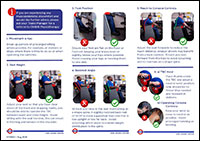Case Study: Transport for London - Musculoskeletal Disorder Risk Assessment of Train Cabs
This case study demonstrates how a change from a reactive to a proactive risk management approach is more conducive to the musculoskeletal health and wellbeing of staff. Here, Transport for London (TfL) provide information on the work they conducted to identify the ergonomic risk factors associated with operating trains.
What risk were TfL addressing?
This work focused on the ergonomic risk factors associated with operating London Underground (LU) trains.
There are several musculoskeletal (MSK) health issues that can arise or be exacerbated by poor train cab design (e.g. interior trim and hard points restricting space), through how users interact with the controls within the cab (e.g. poor location and repetitive use) and the seat set-up (e.g. inadequate adjustment for range of users).
This risk assessment would enable TfL to:
- Identify the risk factors present within train operator cabs for different rolling stock.
- Estimate the likelihood that these risks impacted on musculoskeletal health
- Mitigate the risks identified.
What alerted TfL to the risk?
A better understanding and mitigation of the risk posed to drivers by MSD should result in a reduction of MSD related absenteeism. In 2012, RSSB reviewed existing information, tools and processes to determine whether they are appropriate to assess and manage MSD risk in train drivers. The musculoskeletal risk assessment tool for train drivers (MAT) was subsequently developed and launched in 2012, and made available to RSSB members.
In 2014, the Office of Rail and Road presented its position on MSDs in a paper where it endorsed identifying potential work-related MSD risks at the earliest opportunity using suitably recognised assessment tools.
Until this point there had been no consistent and comprehensive documentation of the ergonomic risk factors associated with operating a train in the rail industry. Ergonomics reviews in the past have typically been reactive to a raised issue relating to MSDs. There were six different types of passenger train rolling stocks on the network, the oldest of which was designed more than 50 years ago. Different types of LU trains have different cab layouts and operating methods (e.g. manual versus automatic trains, in cab or platform-based CCTV equipment for despatch) with different potential causes of MSD risks.
How TfL planned and designed the intervention
A trial was carried out to assess the feasibility of using the MAT in the cab. The trial highlighted discrepancies in the measurement and a review of these found they could largely be eliminated by implementing the following measures:
- An agreement was made about the measurement points on the interface prior to testing.
- A purpose-built rig was designed and made by the LU for an accurate reproduction of the measurement points.
- A standard tape measure was replaced with a laser range finder.
- A consistent team carried out the measurements (a physiotherapist and human factors engineer).
The musculoskeletal risk assessment tool (MAT) was then applied across three different cabs for each of the six different rolling stocks.
Following the physical measurements, a CCTV system was set up in the train cab to allow remote viewing of the train operator operating the train. Three different train operators were used on each line to represent a range of physical dimensions of train operators.
This was the best way to correctly observe the train operator without causing distraction and agreed with the train operators involved, management, and unions in advance. This helped encourage normal train operator behaviour - not what they may have felt they should have been doing if observed in person - which enabled the identification of known and unknown risk factors.
This video footage was used to assess the train operators’ positioning in the cab and allowed for a more accurate application of the Health and Safety Executive’s assessment of repetitive tasks (ART) tool.
How TfL reduced the risks identified?
The assessment did not find any high-risk issues in the train operator’s cabs. However, it highlighted areas which could present MSK risk to train operators given their physical dimensions. For instance, cabs that are more suited to a smaller user may present problems for taller users when setting up.
Guidance documents and instructional videos were produced for each rolling stock train cab to educate the train operators on correct set-up and guidance on what they can do to mitigate against the risks identified. It was agreed that this training would be provided to new train operators, and for an agreed period of time in yearly refresher training. Additionally, a train cab set up checklist is included within the Competency Management System (CMS).
This process equipped TfL with a clearer understanding of the potential issues with each rolling stock cab and can be used by the physiotherapy team when treating train operators experiencing MSD issues.
How will TfL evaluate the intervention?
TfL will continue to collect and monitor data on:
- The number of referrals to occupational health and wellbeing physiotherapy with discomfort caused by cab posture or positioning.
- The number of train operators requesting to move lines (and stock) due to MSD factors related to the cab.
What were the challenges?
The company has been incredibly supportive of this work with management, train operators and unions recognising that it is the right thing to do. The challenge has been finding the time in an already tight training schedule to facilitate this, but skills development (the LU internal training department) has worked hard to get it included.
What has it meant for front line staff and the company?
The information gained from this work will better inform train operators as to which type of train cab better suits their physical dimensions and provide them with information to manage their MSD risks.
Being able to carry this out across several different cabs has provided valuable findings to the company. This knowledge is being carried forward into the design of cabs in newly commissioned deep tube trains, which will result in a better and safer environment for LU train operators. It is also serving to help educate train stock suppliers about the factors that need to be considered and assessed when designing train cabs for LU.


